Why Does Your Facebook Ad Cost Increase Over Time?
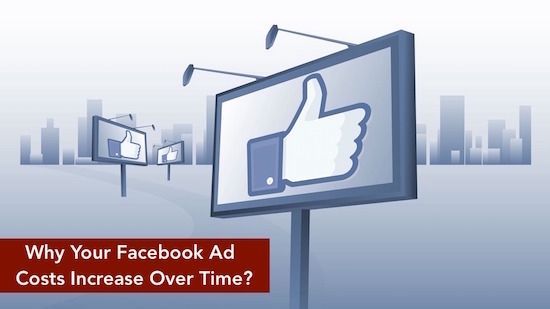
Facebook is one of the best platforms to advertise your products or services online. Their targeting options are insane and the cost of advertising to a high-quality audience is the lowest compared to any other online channel.

A lot of digital marketers get excited when they start advertising on Facebook. They get surprised by the low cost of reaching people and start dreaming of conquering the whole world. However, within a few days, their dreams are shattered because they start observing that their click costs are going up and the conversion ratios are going down.
Many marketers do not understand why this happens. Some people even go to the extent of saying that Facebook is cheating them. The following image represents the emotions of a Facebook advertiser from starting from the excitement of cheap clicks and conversions eventually leading to frustration towards the end of the campaign!
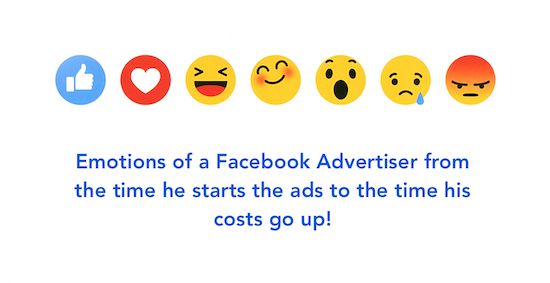
In this post, I want to give you a data-backed answer of why the efficiency of your Facebook ad campaign is short-lived. There are obvious reasons for it, and once you understand them, you will be able to manage your Facebook ads better. You will start the campaigns with realistic expectations and you will have a strategy to scale your campaigns at a controlled cost.
To understand what factors affect your cost, first, we have to thoroughly understand certain metrics that are uber-important when it comes to Facebook advertising.
They are:
- CPM – Cost per thousand impressions
- CTR – Click through rate
- CPTPR – Cost per thousand people reached, and
- Frequency
CPM (Cost Per Thousand Impressions)
CPM is the most important metric in digital marketing, especially paid ads. CPM stands for Cost per Mille (In latin, Mille means 1,000). Though M stands for Mille, we usually refer to CPM as Cost per Thousand Impressions. Here’s Facebook’s definition of CPM:
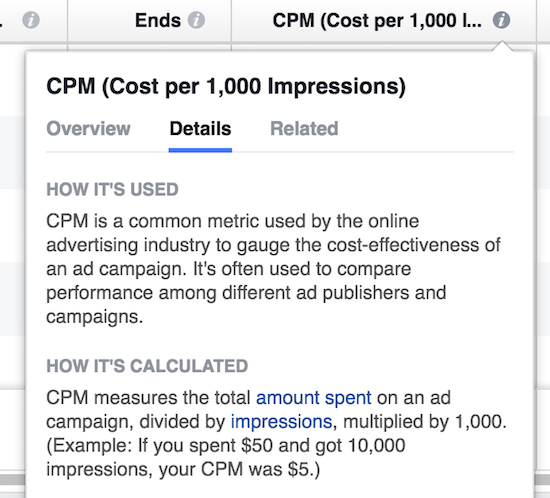
Publishers usually charge advertisers on CPM basis. That’s why most of the content websites try to increase their page views. If you have seen websites which split their articles into several pages, that’s because it increases their page views, and in turn their ad impressions. CPM is the most common way of charging for advertisers for display ads.
Exception: Note that search engines like Google do not charge advertisers on CPM basis, but on CPC (cost per click) basis. And that’s one of the reasons it is attractive to advertisers. They can afford to charge on CPC basis because a search engine’s page views are distributed over a wide list of keyword-triggered search result pages. The same is not true for publishing websites because content websites have a small number of pages visited by a lot of people. The number of search engine result pages are theoretically infinite and each page is visited only by the people who search for those keywords on Google. Contextual text-ads on the Google network are also CPC based.
Content websites cannot afford to charge advertisers on CPC basis because if the advertiser has designed a poor ad which attracts very little clicks, they would end up getting paid less. Someone else’s ad with a higher CTR would perform much better in the same slot, and publishers do not want the trouble of choosing the ad with the highest possible CTR. So they will charge advertisers on CPM basis.
When publishers charge on CPM basis, they need not worry about the CTR, and in turn, the advertiser needs to worry about the CTR!
Which leads us to the next important metric in digital marketing, the CTR. (Remember that in this context Facebook is the publisher and we are the advertisers).
How is CPM calculated?
Facebook calculates the CPM based on the competition to reach the same audience. If a lot of people are advertising to reach the same audience, then the highest bidder is the one who gets through. For example, the audience in the range of 25-35, living in metro cities, who have high income would be costly to advertise to because a lot of advertisers are targeting the same group.
Note that you are not competing with your competitors in the same industry. You are competing with advertisers from different verticals who are targeting the same audience. Also, veteran Facebook advertisers would have noticed that the costs go up during holiday seasons such as Diwali or Christmas/New-Year.
The following factors would influence how much you would pay for every thousand impressions of your ad:
- Your ad objective (Ex: Page likes campaigns cost lower than click campaigns)
- Your Target audience (How many advertisers are trying to reach the same audience?)
- Time of the year (holiday seasons cost more)
- Relevancy score of your ad (ads with higher relevance score cost less)
- Your placement (mobile ads are cheaper than desktop ads)
For a more comprehensive data set on Facebook ad costs across countries and age groups, check out this article on AdEspresso.
CTR (Click Through Rate)
Click through rate is the percentage of people clicking on your ads. If your ad is displayed 100 times and if one person clicks on the ad, your CTR is 1%. If your ad is displayed 1,000 times and if 17 people click on your ads, your CTR is 1.7%.
Why do we need a high CTR?
Digital marketers want a high CTR. Because, as discussed in the CPM section, Facebook and similar platforms charge advertisers on CPM basis and not CPC basis. Though Facebook can show you the metrics in CPCs, they do not charge you for clicks. Facebook charges you on CPM and then shows the metrics as CPC.
Conversion optimized campaigns show cost in CPA (cost per action) but they are also charged for impressions. Here’s a screenshot from my conversion optimized campaign which shows when I get charged:
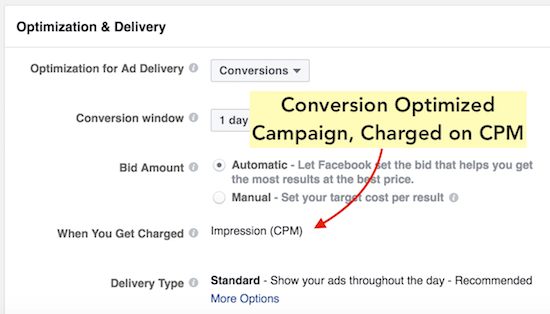
Facebook has a “cost” for displaying an ad everytime to a user – because there are limited ad slots and limited users. Clicks are irrelevant for them. They also cannot show too many ads because that would diminish the user experience of Facebook users.
We, as advertisers should aim to have a high CTRs because high CTRs can reduce the CPCs and the conversion costs, especially when the advertising bill is in CPM. Here’s how Facebook defines CTR:
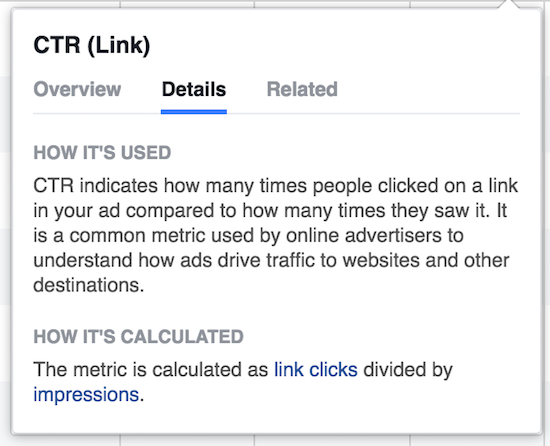
Let’s understand that with an example:
- Let’s say you create an ad, Facebook charges you Rs.100 for 1,000 impressions of the ad. If you get 1% CTR, that’s 10 clicks. You have paid Rs.10 per click (Rs.100, the CPM divided by the total clicks, that is Rs.10 the cost per click, CPC).
- If you get a 2% CTR, you have 20 clicks. Now you have paid only Rs.5 per click (Rs.100/20-clicks). By increasing the CTR by another 1% you have doubled the traffic from the same budget and halved your cost per click.
To put it simply, if you are paying for every impression, it is wise to get the maximum clicks from the impressions as possible. If people see your ad and do not click on it, it is a wasted impression.
Conversely, when you are running PPC ads on search engines, the CTRs do not matter because you pay only for clicks. You might even want to have a low CTR because a low CTR means that only the people who are highly interested are clicking on it, and the quality of the clicks are high.
Factors Influencing CTR
Now that you have understood what CTR is and why we need a high CTR. Let’s look at the different factors that influence your CTR and how you can improve your CTR.
Your Target Audience: If your target audience for your ad is relevant, your CTR will be high. If you get the target audience wrong, your CTR will be low. For example, if I create an ad for men’s shoes and show it to women of 18-25 years age, the ad is irrelevant to the target audience and my CTR would be near to zero. I would be wasting almost all my ad budget.
Targeting your ads to the right online audience is the No.1 factor that influences CTR. Targeting is important, not just for Facebook Ads but also for other digital ads.
In search engines, the targeting is done via search keywords and the buyer intent is very clear. Only in search, you can ignore your audience demographics and interests. If someone is searching for “top digital marketing courses in India”, then it is very clear that he/she is interested in learning digital marketing. You don’t need to worry about demographics here.
With display ads, you are interrupting people and they are not looking for you with search keywords. The buyer intent is not very clear because of lack of search terms. The only way to make the ad relevant to the user is to show it to the right target audience. For that, you should first know who your target audience is.
The Ad Copy and the Ad Image: People decide to click on an ad and learn more about it based on the title of the ad. The title is the shortcut to learning what’s beyond the ad without clicking on the ad. Titles can have a huge impact on your CTR. A poor title can fail your ad campaign. A very good title can improve the CTR by 3x to 5x.
The ad image acts as a visual candy and pulls in the user to read the title. Ad image is also equally important in influencing CTR. The ad description also plays a role but not as much as the ad title and ad image.
Getting the ad copy and ad image right is one of the most difficult puzzles to crack in digital marketing. Not even experienced digital marketers can tell you which ad copy would perform better. We can take an educated guess and look at historical data, but we can find the winner only through split testing.
That’s why A/B testing is very important in digital marketing. If you run two different types of ads, you will know which one gets better clicks and after a certain number, you can conclude who is the winner. Once you get the winner, you try to beat the CTR further by creating an ad that would be even better in terms of CTR.
Cost Per 1000 People Reached & Frequency
CPM and CTR are the usual metrics used in online advertising. Cost Per 1,000 people Reached (CPTPR) & Frequency are metrics specific to only certain platforms of advertising. These metrics help you a lot in optimizing your ad. Not all publishers can give you this data. Facebook does.
When Facebook runs your ad, and if each person looks at your ad once, then the Frequency is 1. Here the Impressions = No. of people reached. The CPM and the Cost per 1,000 people reached would be the same.
However, if the target audience is small and if Facebook shows the ad twice to the same person, then the frequency is 2. If the total impressions are 2,000, but the Frequency is 2, the ad has reached only 1,000 people. Here, the CPM would be twice of Cost per 1,000 people reached.
Here’s Facebook’s definition of Frequency:

If you are running a brand awareness campaign, it is ok to have a high frequency of the ad. However, if you are running a campaign for conversions, then it is recommended that you do not show the ad to the same person for more than 3 times. Because your conversions will start going down after a frequency of 2-3. Which leads us to the next part of this article – understanding how Facebook delivers your ads.
Understanding How Facebook Delivers Your Ad
Assuming that we have the best possible ad copy and image, the another factor which would influence our CTR is the target audience. If your ad targets a very wide audience, then your CTR will be less because of low relevancy. If your ad targets a narrow audience, the audience will find your ad relevant and interesting, and your CTR will be high.
To give you an example, I run an ad on Facebook for my free digital marketing course at LearnDigitalMarketing.com. Here’s how the ad looks:
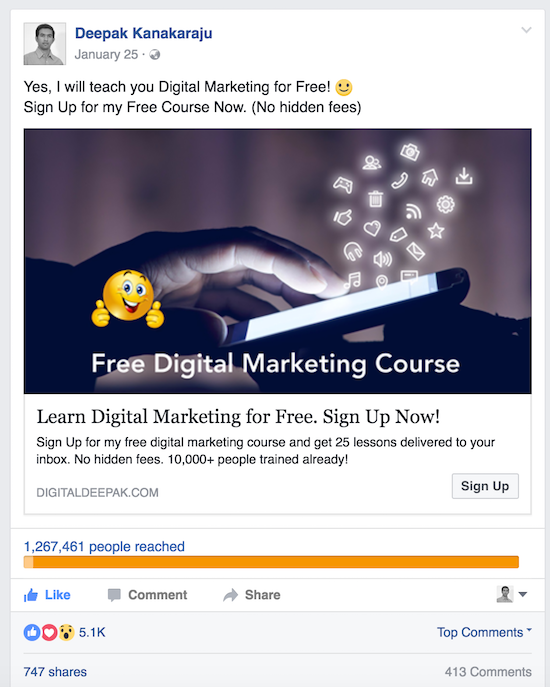
If I target the whole of India for this ad, I can target 35 million people. If I do that, I will be showing my ads to a lot of people who might not be interested in learning digital marketing.
My CTR will be very low and my CPC will be high – which will increase my conversion cost (conversion in this case is a confirmed-optin subscriber at LearnDigitalMarketing.com).
So I need to narrow my audience. To narrow my audience, I add demographic details and interests. After adding all of them, my target audience is now reduced to 3.3 million. (Targeting the right audience with demographics and interests is a huge topic in itself, which we will learn in another post).
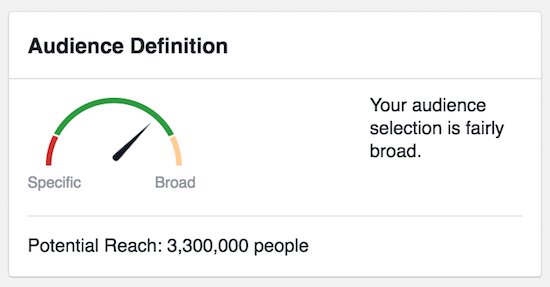
Since I am targeting only 3.3 million people who are likely to be interested in my ad, my CTR will be high. If I show it to all the 35 million people, the CTR will be very low. A high CTR will lead to lower CPCs and lower conversion costs.
Note that I can also reduce my target audience to 1 million by adding more interests and making my audience even narrower, this would increase my CTR even more. But I do not want to do that because it would be difficult to scale my ad in the future when the audience is very narrow.
Unless you are looking for very low number of highly targeted cost-effective conversions, it doesn’t make sense to have a very narrow targeting. If you are looking at getting a lot of conversions over a period of time, it makes sense to have a broader target even if it means that the conversion cost is a bit high initially.
Your pool of “virgin audience” that will see your ad for the first time gets depleted very fast when you have a narrow audience and then your costs start going up, because the same ad will be shown more than once to the same people. You can better understand this by looking at the following two scenarios:
Scenario 1: Narrow Target, Low Initial Costs
If you are targeting a small group of people then your relevancy would be high, your CTR will be high and your conversion cost will be low. However, since your target audience is small, you will deplete your virgin audience very soon and your ad will start showing to the same people again. Someone who has not clicked on your ad for the first time is less likely to click on it when he/she sees the ad for the second time. That’s why the CTR goes down.
This is how your ad will behave as you try to reach more people.

The frequency goes up, CTR goes down and costs start increasing rapidly. The cost would go up very fast in a short period of time and it would reach a point where it becomes unsustainable for you to run the ad.
Scenario 2: Broad Target, Mid to High Initial Costs
If you have a broad target audience for your ad, your relevancy would be lower, CTR would be low and your initial conversion cost would be high. However, since you have a large audience to target, it would take a lot of time before you hit a cap. Your pool of virgin audience yet to see your ad for the first time is very large. Until you hit that cap, your frequency will remain near to 1. Your costs will be stable and predictable.
This is how your ad will behave when you have a broad target:
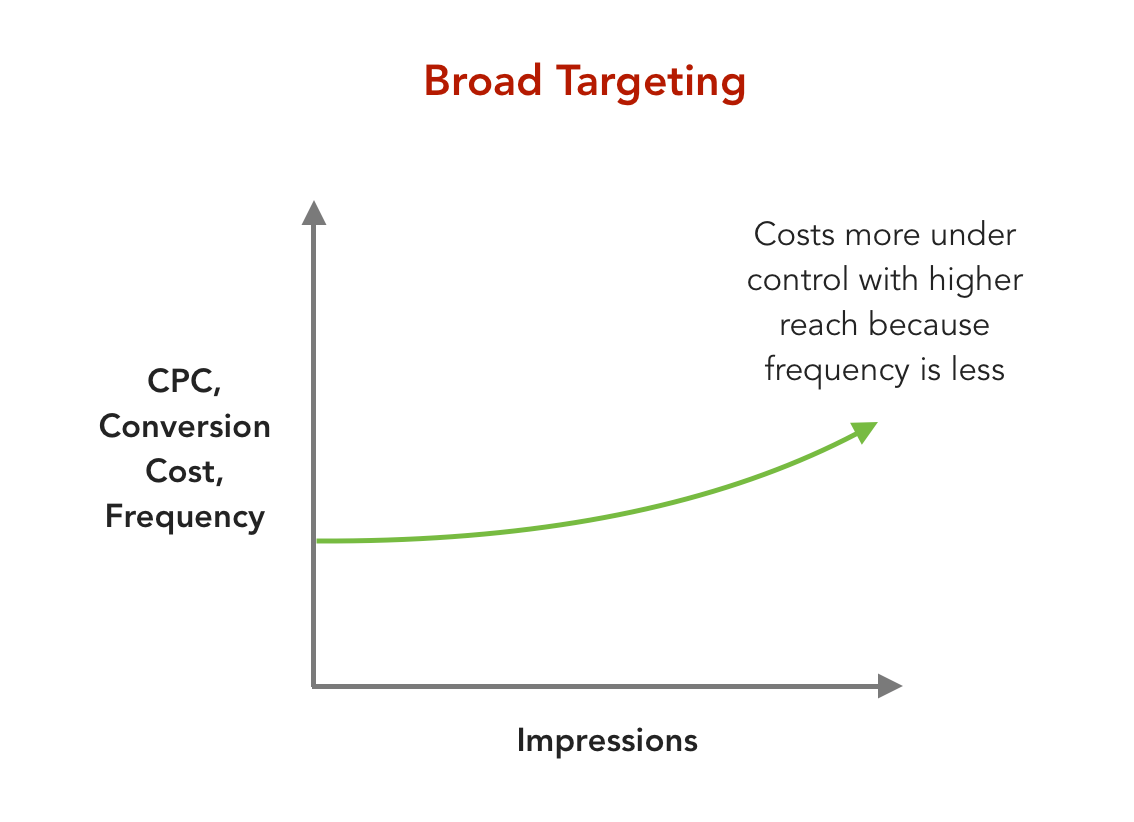
Thus this scenario gives you a campaign that sustains itself for a longer time. If you are looking for a large number of conversions over a long period of time, you should have a broader target even if your initial click and conversion costs are high.
Now, you may have a question: Wouldn’t it be better if you first run an ad with a narrow target audience, enjoy the low CPCs and then when this ad becomes unsustainable, start another ad with a broader target? I had the same question, but after many experiments, I wouldn’t recommend that because as mentioned in the article about Facebook Pixel, Facebook also auto-optimizes your ad for conversions. The more data it has, the better it can optimize for conversions. You do not want to start an ad from scratch and wait for Facebook to optimize your ad every time.
Conclusion
I know this has been a very long blog post but I hope that this answers your question about the strange behavior of Facebook Ads in terms of pricing. Now it is no longer strange for us because we know how their ad engine runs. I hope this blog post also gave you a clear understanding of how display ads and search ads work. This understanding will also help you a lot with future ad campaign strategies.
Recommended Reading from My Blog:
- The Complete Guide to Facebook Pixel for Digital Marketers
- How to Retarget Your Website Visitors on Facebook with Facebook Ads
- How to Get Deeper Insights on Your Website Visitors Using the Facebook Pixel
Any questions? Leave a comment below. Thanks for reading.